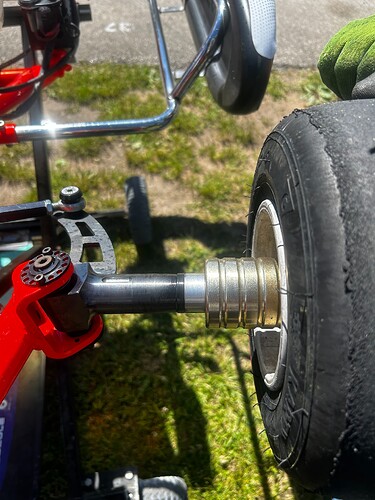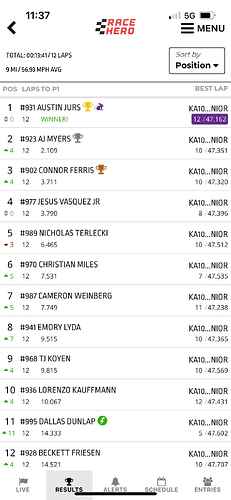Further testing last Friday at Badger to prepare for the USPKS race. It was good to get this soft chassis out on a familiar track so I could directly compare it to the stiffer chassis I was testing to start with. It also gave me a better feel for the differences between the two now that I was on a track I know better than any other.
So after New Castle our basic feeling was this softer chassis was too soft on the front end. We worked against slight understeer basically all weekend in New Castle, and we put that down to the front end being too squishy and just giving up a bit at max load basically. On the stiffer kart, this was less apparent, but with the same basic design just a difference in tubing stiffness and no other changes to offset that softer front end, the kart suffered from a bit of understeer. My main goal Friday was to figure out where that stiffness needed to be increased, so I had two changes I wanted to test out. The first was slightly unconventional, but actually proved to be a pretty noticeable change.
The floopan on the BestKart attaches with a single bolt in the center front, with the two outer tabs just using rubber isolators to hold the pan to the front tube. This obviously gives a lot of flex up front. I wanted to see if stiffening up that front tube was the way to go for better front end feel and less understeer, so I drilled out the pan at those tabs and bolted the pan tightly to the tabs to create three points of attachment to the front tube. Unlike the KR, the floorpan is aluminum on the BestKart, so this provides a fair bit of stiffness.
Turns out this was the wrong way to go for our situation. Bolting the pan to the front tube made a surprisingly big difference to how the kart worked. It felt very similar to putting the front torsion bar in, which makes sense, as you’re stiffening the chassis between the yokes. Ultimately, this made the whole kart noticeably flatter in the corner, removing sidebite, and making the rear of the kart oversteer. Basically it generated flat-sliding, and we lost 0.5 of lap time with that change. So that wasn’t the direction we were looking for.
The next change was to try stiffening the kart outside of the yokes. The BestKart came with some fairly small aluminum front hubs, and we had speculated they were too soft and too small to provide the front end we needed. So I grabbed some 92mm magnesium hubs (Driveline) to test of a longer, stiffer hub would make a difference.
This was a much more positive change. We kept the same track width, only changing the actual hub. The front end felt way more reactive with this, and the rear freed up a little without sliding too much or binding the chassis up on exit. In total we gained 0.4 with this change and I was REALLY happy with the balance of the kart. BestKart offers different front stub axles that are stiffer as well as longer hubs too, so they will be sending over those things to test next and see if those components are the correct baseline for this softer chassis. We also will be getting different steering shafts to try as some point I think as well.
From that test, it would appear to me that the actual tubing isn’t the weak link in terms of stiffness in the front end, it would be whatever is outside of the yokes that is giving up at full corner load. Stiffening the front up between the yokes only flattens the whole kart and doesn’t yield that much improvement to front feel, so it’s a lose-lose. But if we can get the kart stiffer outside the yokes like we did with the hub, I think that would solve the understeer issue. I plan on making longer hubs/stiffer stubs the standard baseline on my kart for now.
The only other thing I tested was the 3F vs 9F wheels back-to-back. I already knew what to expect but wanted to get a tangible number on how the different wheels control the tire temp. I found the 3Fs to start giving up around lap 11-12 on this particular day, where the 9Fs stayed consistent for 22 laps when I put them on. The track temp even rose for that run on the 9Fs and the tire still stayed in for the whole stint, with my fast lap coming on lap 22.
Along the same vein with regards to tires, with the base setup and front hub, we were seeing a noticeable difference in front tire temp/pressure growth compared to the rear tires. Fronts were definitely overheating and growing pressure more. With the stiffer front hub, the tire temps flipped; the rears were now slightly hotter/higher pressure at the end of the run compared to the fronts, and overall hot temps/pressures were a lot closer front to rear.
One thing I notice on this chassis is that it responds strongly to changes. Every change we’ve made has been pretty noticeable from a driving standpoint. On my OTK I found the adjustments to produce much more subtle results. I like the BestKart for this because you end up making really minor changes and it makes a difference. A lot of times on OTK I would make a change and it wouldn’t really feel too different session to session, though it would be obvious that the kart was working better or worse. Just took a lot more sensitivity from the driver to detect those differences. Here the changes are very easy to feel. Gives me more confidence session-to-session knowing that if I change something, it WILL make the kart different. And so far every change is working as expected mostly, so it feels like we have good knowledge going forward and can develop a tuning plan quickly for each weekend.
VERY excited to get down to business at USPKS in a couple weeks.





